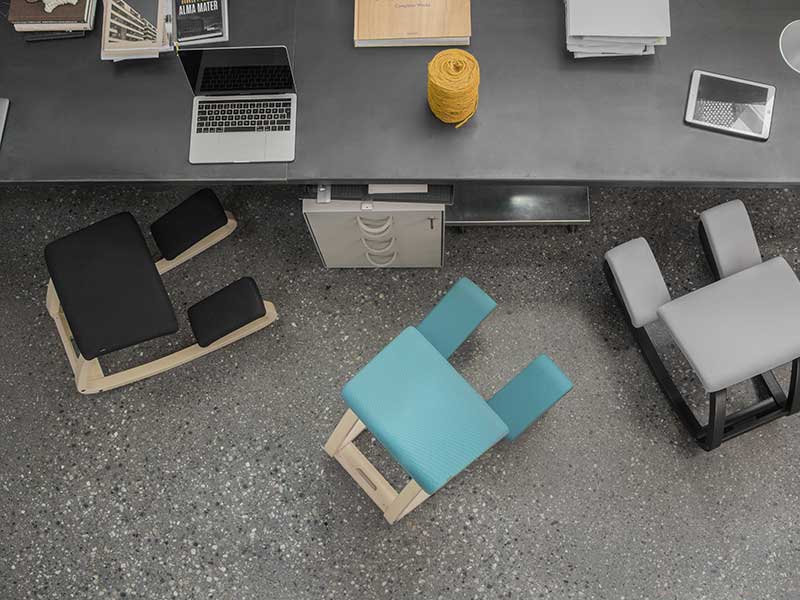Are you tired of going home from work every day with a stiff and sore back? It might be time to invest in an office kneeling chair.
Kneeling chairs, or ergonomic kneeling chairs, have a boatload of benefits compared to traditional desk chairs. Potentially, they could be a complete replacement for your current chair, or a part-time option that keeps you moving, engages your core muscles, and avoids the aches and pains that can arise from sitting in a traditional office chair for eight hours or more a day.
What Is an Office Kneeling Chair?
Before looking at the benefits of office kneeling chairs (and a few potential negatives), it’s essential to understand what precisely a kneeling chair is.
The term “kneeling chair” has been around for a long time. Norwegians built the first kneeling chair in the 1970s. Many of the early versions weren’t ergonomically designed. The term “ergonomic” refers to the applied science of equipment design.
In the workplace context, the ergonomic design intends to reduce worker fatigue and discomfort. So, an ergonomic office kneeling chair is designed to help ensure and support correct posture for your neck, back, and legs as you work. In an ergonomic kneeling chair, your thighs are dropped to an angle of 60-70 degrees as opposed to 90 degrees in a traditional chair, and you get a 110-degree angle from buttocks to back as your hips and pelvis are moved forward. The shins, not just the glutes, support your body weight.
While they are called kneeling chairs, you aren’t limited to kneeling. There is a wide variety of kneeling chairs, allowing you to pick one that fits your sitting preferences. Because they allow for a wide range of motion, typical users of modern kneeling chairs find them quite comfortable.
What Are the Benefits of Kneeling Chairs Vs. Traditional Office Chairs?
Reduction of Back Pain
There are several benefits to kneeling chairs, but perhaps the most popular is the reduction of back pain. According to data reported by the American Chiropractic Association, approximately 31 million Americans experience low back pain at any given time. Back pain is a leading cause of missed work time, with one-half of all working Americans complaining of back pain symptoms every year. Back Pain Facts and Statistics.
Maintaining proper posture is difficult in standard office chairs, especially if sitting for long periods. Ergonomic office kneeling chairs promote good posture. The steeper angle of kneeling chairs puts less pressure on your back. Many kneeling chairs also allow you to move and use rocking motions to keep yourself more active, strengthening your core muscles – which, in itself, helps to alleviate back pain — in the process. In short, kneeling chairs promote what is known as “active sitting.”
An ergonomically designed kneeling chair allows the spine to maintain its natural curvature, which reduces pain from the neck and shoulders down to the lower back. In addition, the body’s weight is evenly distributed in a kneeling chair, taking pressure off the hips and relieving tension on the back.
An ancillary benefit of less neck, shoulder, and back pain is increased productivity as the distraction of pain is alleviated.
Other Benefits of Ergonomic Kneeling Chairs
Kneeling chairs can improve your oxygen intake, blood circulation, and digestion. When you have proper posture, your internal organs, including your lungs and intestines, aren’t compressed, and their function improves. It is much harder to slouch in a kneeling chair than in a traditional chair.
The benefits of good posture and improved organ functioning can include less chance of cramping and constipation. Breathing improves in a kneeling chair, and the improved oxygen intake results in more oxygen reaching the brain, enhancing productivity.
Ergonomic kneeling chairs promote blood circulation, which means nutrients are moved throughout the body and to the brain more efficiently, resulting in increased focus, energy, and mood improvement.
We’ve been focusing on kneeling chairs for the office, but even if you don’t have an office job, kneeling chairs can be beneficial if you have a hobby that requires sitting in a traditional chair for lengthy periods—for example, writing, crafts, sewing, and knitting.
Are There Cons to Kneeling Chairs?
Potential cons to kneeling chairs can be limited significantly if you buy the right size chair. A kneeling chair that doesn’t fit properly can actually increase pain and stiffness.
Kneeling chairs that are too small for your body type will restrict leg room and movement. As a result, you will sit awkwardly on the chair, likely resulting in back and joint pain. A chair that’s too big isn’t good either, as it could result in sitting on the edge of the seat, reaching forward too much, slouching, or slumping.
Positioning and mobility of the kneeling chair is another essential consideration. Proper positioning and mobility ensure that you can comfortably reach your keyboard, see your computer monitor and reach any additional work items on your desk you may need.
Finally, kneeling chairs typically have you sitting higher off the floor than traditional chairs. As such, it’s important to adjust the height of your computer and other tools you work with regularly to maintain an optimal ergonomic working space.
What’s the Best Way to Use a Kneeling Chair?
The idea behind ergonomics is to make your workstation as comfortable as possible to increase your well-being and productivity. The most important part of an ergonomically designed office is the chair in which you will spend most of your time.
When you use a kneeling chair for the first time, it can take a short time for your body to get used to the change. For example, the pressure on shins resting on the kneeling chair’s knee pads may cause some discomfort for a few days.
As such, for a lot of people, it’s best to begin using a kneeling chair by alternating the new chair with a traditional chair.
What Should You Look for When Shopping for an Ergonomic Office Chair?
There are several things to consider when looking for an office kneeling chair.
First, make sure the chair is a good fit for your body shape and size and makes sense for your daily work tasks.
Second, getting an adjustable kneeling chair is critical to set it up in a way that results in the most ergonomic benefits.
Third, find a kneeling chair that’s comfortable for you. If you don’t feel the chair is comfortable, you’ll unlikely keep using it, no matter the ergonomic benefits. Many people like kneeling chairs with back supports. Good back support will enhance comfort and help to maintain proper posture.
How Much Do Office Kneeling Chairs Cost?
As a general rule, kneeling chairs are typically more affordable than traditional office chairs.
See how much kneeling chairs cost? Price variation depends on size, brand, quality, warranty, and type of chair. The average cost of a kneeling chair is approximately $300, but a kneeling chair can run anywhere from $85 all the way up to $2000.
There are things to consider beyond price when looking at the cost of ergonomically designed office kneeling chairs.
For example, do the benefits of an ergonomically designed office kneeling chair outweigh the disadvantages? If so, a strong case can be made that the kneeling chair price is worth it.
Well-constructed kneeling chairs are sturdy and long-lasting, saving you money in the long run. In addition, because they are great for your posture, kneeling chairs can save you money on chiropractic visits and pain medications over time.
A Final Thought
Since the pandemic’s start, more people have been working at home instead of in office buildings. In many cases, homework stations aren’t as ergonomically sound as typical office workspaces.
Chairs tend to be of lower quality, computers are often not set at the proper height, and home desks (or kitchen tables, in some cases) are usually situated in such a way that many items needed to complete everyday work tasks aren’t readily in reach.
As more people work from home — or continue working from home post-pandemic — the demand for ergonomically friendly kneeling chairs is likely to rise.



